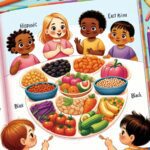Understanding Nutritional guidelines for 2-year-olds: What parents should know is crucial for the healthy development of your child. This stage of life is marked by rapid growth, increased activity, and developing taste preferences, making nutrition an essential focus for parents. Let’s dive deep into what makes a balanced diet for toddlers and how you can ensure they get all the nutrients needed for optimal growth.
Nutritional Guidelines for 2-Year-Olds: What Parents Should Know
At the age of two, toddlers require a diet that’s rich in variety and nutrients. According to the American Academy of Pediatrics, parents should aim for a balance of fruits, vegetables, whole grains, protein, and dairy. This balance ensures toddlers get a wide range of nutrients necessary for their development, such as calcium, iron, vitamin D, and omega-3 fatty acids. A great resource for parents seeking detailed dietary guidelines is the USDA’s MyPlate initiative, which offers age-specific advice (source).
Portion control is also a crucial aspect of feeding 2-year-olds. Since toddlers have smaller stomachs, they require less food than adults. Offering small, frequent meals and snacks can help meet their energy needs without overwhelming them. It’s important to listen to your child’s hunger and fullness cues to avoid overfeeding or underfeeding.
Key Nutrients and Their Sources
When discussing Nutritional guidelines for 2-year-olds: What parents should know, highlighting key nutrients is essential. Iron, found in lean meats, beans, and fortified cereals, is crucial for cognitive development. Calcium and vitamin D, important for bone growth, can be sourced from dairy products, fortified plant-based milks, and sunlight exposure. Omega-3 fatty acids, found in fish like salmon, are essential for brain development.
Additionally, fiber plays a significant role in a toddler’s diet, aiding digestion and preventing constipation. Whole grains, fruits, and vegetables are excellent fiber sources. Ensuring a varied diet will naturally incorporate these key nutrients, promoting overall health and development.
Dealing with Picky Eaters
One challenge in adhering to Nutritional guidelines for 2-year-olds: What parents should know is managing picky eaters. It’s not uncommon for toddlers to be wary of new foods or to prefer a limited selection of meals. However, there are strategies to encourage a more varied diet without turning mealtime into a battle.
Introducing new foods alongside familiar favorites can gradually expand a child’s palate. It’s also beneficial to involve toddlers in food selection and preparation, as this increases their interest in trying new foods. Consistency and patience are key, as it often takes multiple exposures to a new food before a child will accept it.
In conclusion, adhering to Nutritional guidelines for 2-year-olds: What parents should know is foundational for ensuring your child’s healthy development. By focusing on a balanced diet, being mindful of key nutrients, and employing strategies to manage picky eaters, parents can provide the nutritional support their toddlers need during this critical stage of growth. Remember, every child is unique, and what works for one may not work for another. Stay patient and flexible, and consult with a pediatric nutritionist or healthcare provider if you have concerns about your child’s diet or nutritional needs.
For more information on introducing solid foods and managing dietary challenges, explore our resources on introducing solid foods to babies with allergies, boosting the immune system in toddlers, and dealing with picky eaters.













